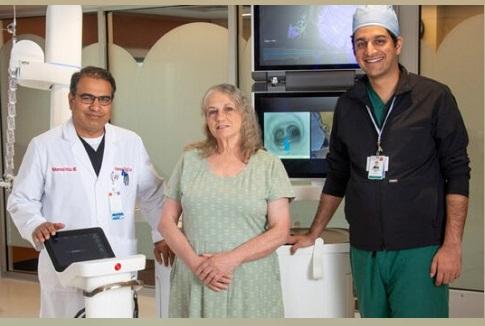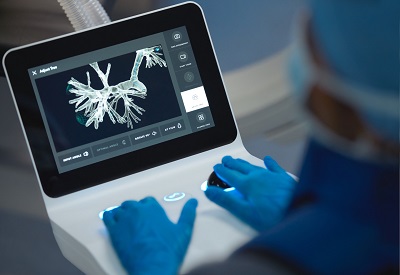
Transforming Lung Cancer Diagnosis
For the Pulmonary Department, the Ion gives physicians a chance to intervene and diagnose cancer early, before symptoms occur, for those who have regular screenings—ultimately saving lives. Candita Lee believes that’s exactly what happened to her after she received the Ion robotic bronchoscopy.
Read Her Story >

Ion Robotic Bronchoscopy
Advancing Lung Cancer Detection with Robotic Bronchoscopy
At UHS, our pulmonologists and thoracic surgery team are committed to raising the standard of care for peripheral lung nodules, including lung cancer, from the moment of diagnosis through treatment. We are home to the Ion, a robotic-assisted bronchoscopy tool used to perform lung biopsies with precision. With its advanced mapping technique and flexibility, the Ion helps physicians target small, hard-to-reach nodules that were previously inaccessible.
Diagnosing lung nodules early with leading technology. Timely diagnosis of peripheral lung lesions, especially early-stage cancer, is key to improving patient outcomes. The Ion supports early lung cancer diagnosis by enabling physicians to reach small nodules, even in the deepest areas of the lung.
Instead of a “wait and see” approach in which suspicious lesions are monitored over time, physicians can quickly target and biopsy nodules with Ion, enabling them to catch lung cancer and other related lesions early when treatment is most effective. This also spares patients from extra follow-up visits and reduces the risk of recurrence.
Robotic-assisted bronchoscopy can also help:
- Diagnose other lung conditions - Such as infections and inflammatory conditions
- Ensure faster recovery after surgery - The Ion’s precision allows physicians to target a smaller amount of lung tissue, which can help reduce recovery time
- Improve surgical outcomes - The Ion can assist in marking small lesions that help guide surgeons during lung cancer surgery
How does the Ion work?
- When a suspicious lung nodule is detected, the Ion generates a 3D map of the patient’s lungs using a CT scan and identifies the safest and most efficient route through the lung to the nodule or mass.
- Unlike traditional bronchoscopy, during which a doctor manually guides a thin tube (bronchoscope) through the patient’s airways to the lungs, the Ion is guided by a robotic arm controlled by a physician.
- Once the path is determined, a bronchoscopy is performed through the mouth using the system’s ultra-thin, ultra-maneuverable catheter to reach the lung nodule or mass, where it is biopsied.
- With the Ion’s ultra-thin, ultra-maneuverable catheter, physicians can access all parts of the lungs--including areas that were previously unreachable with the traditional bronchoscope.
- Shape-sensing technology communicates the catheter’s location via an external monitor, allowing for seamless navigation and a more precise biopsy.
- The physician then takes a tissue sample by employing biopsy tools through the catheter which is held securely in place.
To see the Ion Robot in action, click here.
UHS is the first hospital system in the Southern Tier to offer Ion, a minimally invasive option for earlier detection and treatment of lung cancer. We look forward to providing the care you need.


